人教版PEP四年级下册英语Unit 4 导学案(分课时)
- 格式:doc
- 大小:46.00 KB
- 文档页数:8
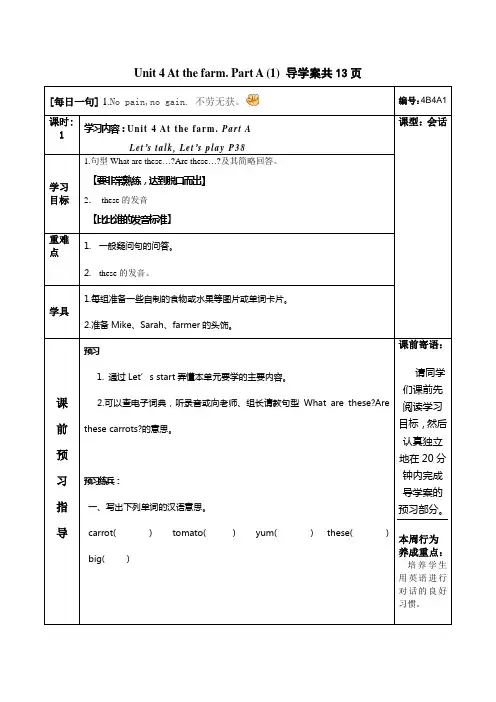
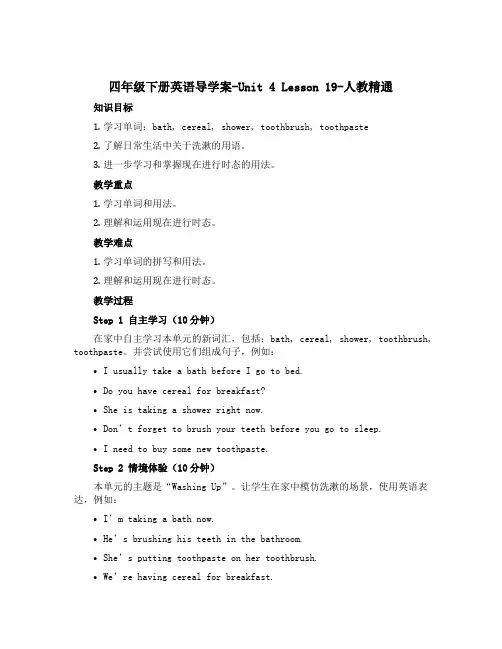
四年级下册英语导学案-Unit 4 Lesson 19-人教精通知识目标1.学习单词:bath, cereal, shower, toothbrush, toothpaste2.了解日常生活中关于洗漱的用语。
3.进一步学习和掌握现在进行时态的用法。
教学重点1.学习单词和用法。
2.理解和运用现在进行时态。
教学难点1.学习单词的拼写和用法。
2.理解和运用现在进行时态。
教学过程Step 1 自主学习(10分钟)在家中自主学习本单元的新词汇,包括:bath, cereal, shower, toothbrush, toothpaste。
并尝试使用它们组成句子,例如:•I usually take a bath before I go to bed.•Do you have cereal for breakfast?•She is taking a shower right now.•Don’t forget to brush your teeth before you go to sleep.•I need to buy some new toothpaste.Step 2 情境体验(10分钟)本单元的主题是“Washing Up”。
让学生在家中模仿洗漱的场景,使用英语表达,例如:•I’m taking a bath now.•He’s brushing his teeth in the bathroom.•She’s putting toothpaste on her toothbrush.•We’re having cereal for breakfast.•They’re taking a shower together.Step 3 探究学习(20分钟)1.学习现在进行时态的定义和用法。
现在进行时态本身是一个形式为“be + V-ing”的动词时态,通常表示现在正在进行中的动作或状态。
例如:•I am studying English right now.•They are playing soccer in the park.•She is cooking dinner for us.2.将现在进行时态应用在本单元的句子中,例如:•I’m taking a bath now.(我现在正在洗澡。
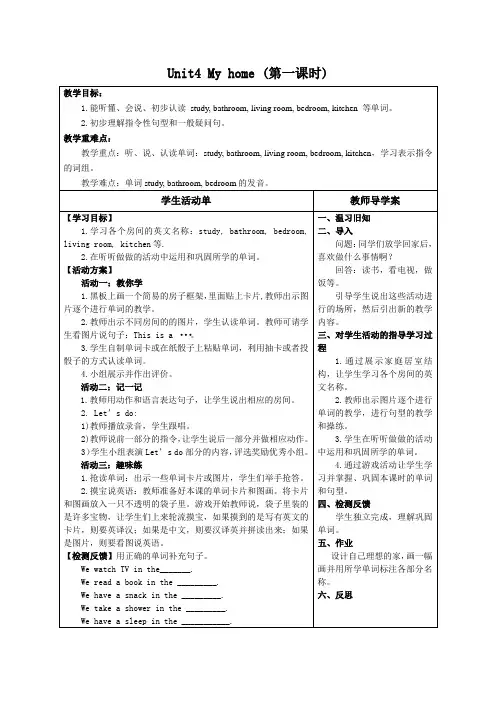
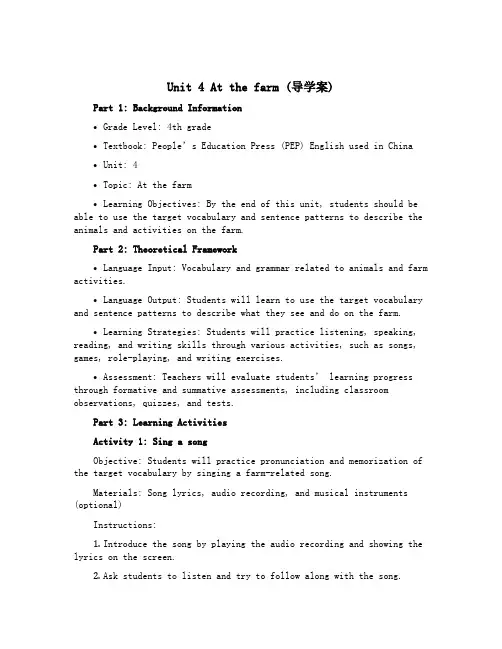
Unit 4 At the farm (导学案)Part 1: Background Information•Grade Level: 4th grade•Textbook: People’s Education Press (PEP) English used in China•Unit: 4•Topic: At the farm•Learning Objectives: By the end of this unit, students should be able to use the target vocabulary and sentence patterns to describe the animals and activities on the farm.Part 2: Theoretical Framework•Language Input: Vocabulary and grammar related to animals and farm activities.•Language Output: Students will learn to use the target vocabulary and sentence patterns to describe what they see and do on the farm.•Learning Strategies: Students will practice listening, speaking, reading, and writing skills through various activities, such as songs, games, role-playing, and writing exercises.•Assessment: Teachers will evaluate students’ learning progress through formative and summative assessments, including classroom observations, quizzes, and tests.Part 3: Learning ActivitiesActivity 1: Sing a songObjective: Students will practice pronunciation and memorization of the target vocabulary by singing a farm-related song.Materials: Song lyrics, audio recording, and musical instruments (optional)Instructions:1.Introduce the song by playing the audio recording and showing the lyrics on the screen.2.Ask students to listen and try to follow along with the song.3.Play the song again and encourage students to sing along.4.Optional: Give students musical instruments, such as tambourines or shakers, to play along with the song.5.Repeat the song several times until students feel confident singing it.Activity 2: Play a matching gameObjective: Students will review and reinforce their knowledge of the target vocabulary by playing a fun matching game.Materials: Flashcards with pictures of animals and activities on the farm, printed labels with the corresponding names, and a timer.Instructions:1.Distribute the flashcards and labels to students.2.Set a timer for 1-2 minutes.3.Ask students to match the pictures with the correct names and place them on the table.4.Check their answers as a class and provide feedback.5.Repeat the game several times, gradually increasing the difficulty level.Activity 3: Role playObjective: Students will apply the new vocabulary and grammar structures by role-playing farm-related scenarios.Materials: Props and costumes related to the farm theme, scripts with dialogues between different characters.Instructions:1.Split students into groups and assign different roles, such as farmer, animal, tourist, etc.2.Provide props and costumes for each group to enhance their role-playing experience.3.Give each group a script with a dialogue between the characters, using the target vocabulary and sentence patterns. Encourage students to improvise and add their own lines.4.Ask students to rehearse their roles and perform for the class.5.Give feedback on the performance and encourage peer evaluation.Activity 4: Writing exerciseObjective: Students will apply their reading and writing skills to create a short story or diary entry about a farm visit.Materials: Paper, pencils, and animal stickers (optional)Instructions:1.Ask students to recall their recent farm visit or imagine one in their mind.2.Provide a writing prompt, such as。

第四单元四年级英语导学案课题 Unit4At the farm 总课时 6 课时 Lesson1年级四主备人授课人课型新授班级一、教学方法情景教学法学习准备教师准备录音机和录音带,图片学生准备笔和纸,词卡学习目标知识目标能听、说、认读单词:tomato、green beans、potato、carrot以及它们的复数形式。
能力目标能听懂会说句子:look at the green beans,They’re so long.Yes,and the potatoes are big. 情感态度培养学生积极与他人合作的优良品质。
重点难点新词汇的听说认读. 单词tomato和potato的复数形式。
二、导学过程导学过程二次备课自主学习课前复习:复习前面学过的有关食物和水果的名称的单词课前预习:试读Let’s learn 中的单词全体学生呼英语励志口号: No pains.No gains .(没有付出就没有收获)三、热身、复习:1. 请学生欣赏Let’s chant部分歌谣,教师要根据歌词适时举起相应的图片。
四、导入新课,板书课题。
展示本课学习目标,学生齐读本课学习目标。
1.板书课题2.展示本课教学目标知识目标能听、说、认读单词:tomato、green beans、potato、carrot 以及它们的复数形式。
能力目标能听懂会说句子:look at the green beans,They’re so long.Yes,and the potatoes are big. 情感态度培养学生积极与他人合作的优良品质。
五、导入并指导学习新的内容:1、教师手举一个西红柿,说:I like tomatoes. Do you like tomatoes?引导学生用I like …或I don’t like…根据自己的实际情况表达。
2、教师再拿起一夹青豆,边说边完全呈现:Oh,it’s long and green. They are green beans. Do you like green beans? 让学生在回答中学习单词。
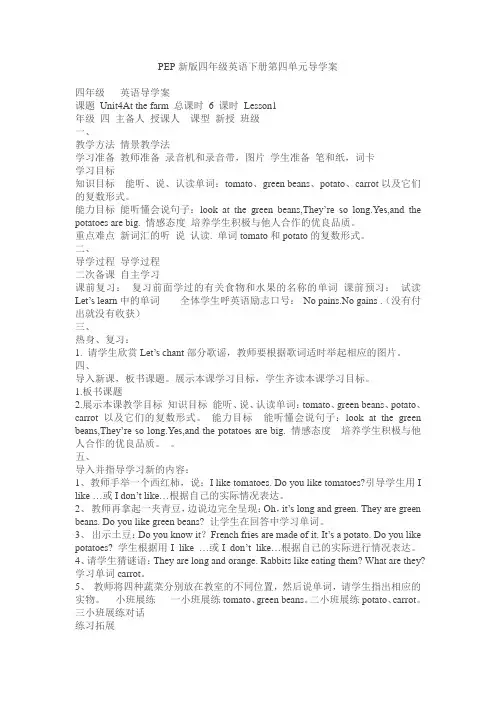
PEP新版四年级英语下册第四单元导学案四年级英语导学案课题Unit4At the farm 总课时 6 课时Lesson1年级四主备人授课人课型新授班级一、教学方法情景教学法学习准备教师准备录音机和录音带,图片学生准备笔和纸,词卡学习目标知识目标能听、说、认读单词:tomato、green beans、potato、carrot以及它们的复数形式。
能力目标能听懂会说句子:look at the green beans,They’re so long.Yes,and the potatoes are big. 情感态度培养学生积极与他人合作的优良品质。
重点难点新词汇的听说认读. 单词tomato和potato的复数形式。
二、导学过程导学过程二次备课自主学习课前复习:复习前面学过的有关食物和水果的名称的单词课前预习:试读Let’s learn中的单词全体学生呼英语励志口号:No pains.No gains .(没有付出就没有收获)三、热身、复习:1. 请学生欣赏Let’s chant部分歌谣,教师要根据歌词适时举起相应的图片。
四、导入新课,板书课题。
展示本课学习目标,学生齐读本课学习目标。
1.板书课题2.展示本课教学目标知识目标能听、说、认读单词:tomato、green beans、potato、carrot以及它们的复数形式。
能力目标能听懂会说句子:look at the green beans,They’re so long.Yes,and the potatoes are big. 情感态度培养学生积极与他人合作的优良品质。
五、导入并指导学习新的内容:1、教师手举一个西红柿,说:I like tomatoes. Do you like tomatoes?引导学生用I like …或I don’t like…根据自己的实际情况表达。
2、教师再拿起一夹青豆,边说边完全呈现:Oh,it’s long and green. They are green beans. Do you like green beans? 让学生在回答中学习单词。

四年级下册英语导学案- Unit 4 Hobbies Fun Time 人教新起点一、教学目标1.学会问与回答关于“爱好”的问题。
2.学会运用新单词“collect”、“stamp”、“coin”等。
3.学会将自己的爱好用英语表达出来。
4.能够提高自己的英语听说能力,学习新的语言知识。
二、教学重点与难点•教学重点:学生们能够学会问与回答关于“爱好”的问题。
•教学难点:学生们能够将自己的爱好用英语表达出来。
三、教学环节1. Warm up让学生们说出自己的爱好,并通过图片让学生们预测下面的课程内容。
2. Presentation向学生们介绍新单词:Collect, stamp, coin, post, like。
并且通过举例子及图片让学生们丰富单词的理解。
3. Practice根据课本内容,让学生们互相询问关于“爱好”的问题,鼓励学生们用英语进行回答。
同时,要求学生们在问答中使用新单词。
4. Production针对学生们的实际情况,让学生自己写一篇短文,介绍自己的爱好。
5. Extension通过小组活动的形式,让学生们进行分组讨论,讨论最喜欢的爱好,并向同学介绍自己的爱好。
四、教学方法•问答式互动学习•图片辅助学习•小组讨论五、教学评价•通过学生们的回答,检查学生对于新单词的理解情况。
•评价学生自己的写作能力,以及对于“爱好”话题的掌握情况。
•考察学生们的互动交流情况。
六、总结Unit 4 Hobbies Fun Time 是四年级下册的一个单元,本单元主要涉及到关于“爱好”的话题,学生们通过课程的学习,能够提高自己的英语口语能力,学习新单词,表达自己的爱好,并知道如何与同学分享自己的爱好。
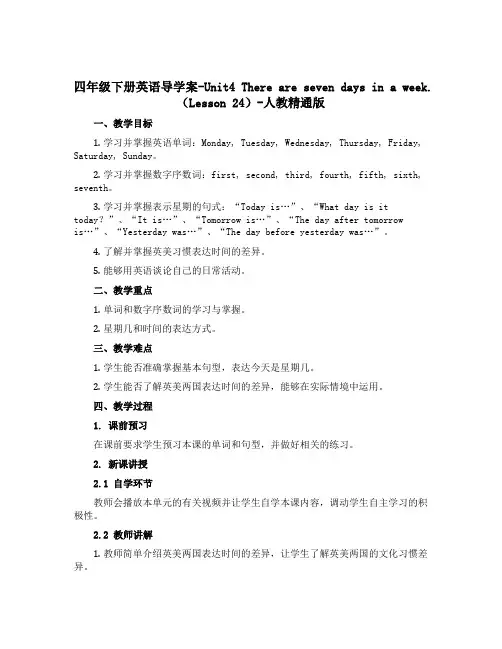
四年级下册英语导学案-Unit4 There are seven days in a week.(Lesson 24)-人教精通版一、教学目标1.学习并掌握英语单词:Monday, Tuesday, Wednesday, Thursday, Friday, Saturday, Sunday。
2.学习并掌握数字序数词:first, second, third, fourth, fifth, sixth, seventh。
3.学习并掌握表示星期的句式:“Today is…”、“What day is it today?”、“It is…”、“Tomorrow is…”、“The day after tomorrow is…”、“Yesterday was…”、“The day before yesterday was…”。
4.了解并掌握英美习惯表达时间的差异。
5.能够用英语谈论自己的日常活动。
二、教学重点1.单词和数字序数词的学习与掌握。
2.星期几和时间的表达方式。
三、教学难点1.学生能否准确掌握基本句型,表达今天是星期几。
2.学生能否了解英美两国表达时间的差异,能够在实际情境中运用。
四、教学过程1. 课前预习在课前要求学生预习本课的单词和句型,并做好相关的练习。
2. 新课讲授2.1 自学环节教师会播放本单元的有关视频并让学生自学本课内容,调动学生自主学习的积极性。
2.2 教师讲解1.教师简单介绍英美两国表达时间的差异,让学生了解英美两国的文化习惯差异。
2.教师利用幻灯片或黑板,介绍本单元的单词和数字序数词,让学生按照正确的读音读单词,并熟记数字序数词的顺序。
3.教师通过一些实际情境,让学生准确掌握句型、“Today is…”、“What day is it today?”、“It is…”、“Tomorrow is…”、“The day after tomorrow is…”、“Yesterday was…”、“The day before yesterday was…”。

Unit 4 At the farmPart A教学导航教学内容Let’s learn Let’s chant Let’s talk Let’s spell教学目标【知识目标】能听、说、认读单词tomato,green bean,potato,carrot及其复数形式。
【能力目标】让学生能介绍各种蔬菜。
【情感目标】热爱蔬菜,热爱生活。
教学重点 1.能听懂、会说、认读Let's learn部分的单词tomato,green bean,potato,carrot及其复数形式。
2.要求学生能听懂本部分重点句型,并能结合这些句子表达的情境,恰当地替换句中的单词。
3.让学生掌握字母组合or在单词中的发音规律。
教学难点可数名词复数形式的掌握,以及问句复数形式的回答。
课时安排3课时。
教学准备图片、蔬菜卡片、PPT、录音机、磁带等。
教学过程第一课时教学过程批注一、Warm-up & Revision1.Say hello to students.2.Sing a song“An apple a day”.二、Presentation & Practice1.将西红柿的图片展现并贴在黑板:What’s this?引导学生回答:It’s a tomato.(同样的方法引出其他蔬菜的单词并板书)2.教师指着西红柿,把之前画好的2个西红柿图片贴上,并询问:How many tomatoes do you see?引出其复数形式并用红色粉笔做好记号。
3.快闪游戏。
反复闪现一些蔬菜卡片,学生大声快速读出单词。
看谁反应快。
4.课件出示菜园或蔬菜图片,同桌互相描述自己喜欢的蔬菜:I like potatoes.They are so big.5.请学生根据蔬菜园的图片,扮演向导介绍几种蔬菜的特征。
6.播放Let’s learn部分的录音,学生跟读模仿。
让学生在真实的语境中运用英语,给他们创造一个自然习得的英语环境。

四年级下册英语导学案-Unit 4 Hobbies Lesson 2 (1)一、教学目标 Objectives1.通过学习本课内容,学生能够掌握运动器材名称,并能使用“I can…”句型表达自己擅长的活动;2.能够理解并运用本课对话中的日常用语及短语;3.能够运用所学知识进行游戏或小组交流,并能参与到小组活动中。
二、教学重点 Key Points1.运动器材名称;2.“I can…”句型;3.日常用语及短语。
三、教学难点 Difficult Points运动器材的发音及拼写。
四、教学内容 Teaching Contents1. 活动一:词汇练习步骤:1.师生一起回顾并复习Unit 4中已学过的运动器材名称,包括ball、jumprope、hula hoop、skipping rope、frisbee等;2.老师可自行设计运动器材展示图片,让学生快速识别并说出其名称,或配合运动器材的具体应用场景,让学生能够直观地感受到该器材的实际使用效果。
学生活动:1.学生跟着老师快速朗读或模仿词汇;2.学生通过观察图片或介绍,说出运动器材的名称以及用途。
2. 活动二:听力练习步骤:1.播放Lesson 2录音,让学生重点听第一、二段对话;2.学生可以借助课本或黑板上的相关图片,全神贯注地听取对话内容,并尝试通过上下文理解对话大意。
学生活动:1.学生听录音,进行听力训练;2.学生可以分组,讨论对话内容及自己的理解;3.学生将对话内容用自己的语言复述给其他同学听。
3. 活动三:口语练习步骤:1.学生结合课本图片,回顾运动器材的名称及用法;2.学生模仿Lesson2中对话,运用“I can…”句型表达自己喜欢的运动器材及擅长的活动;3.学生可以自由组队,进行小组交流或配合其他同学进行相关的口语练习,如:“What can you do with a ball?”等。
学生活动:1.学生模仿对话,尝试使用“I can…”句型;2.学生可以借助图片,进行简单的口头练习;3.学生可以分组或两人一组,进行小组交流或双方问答练习。
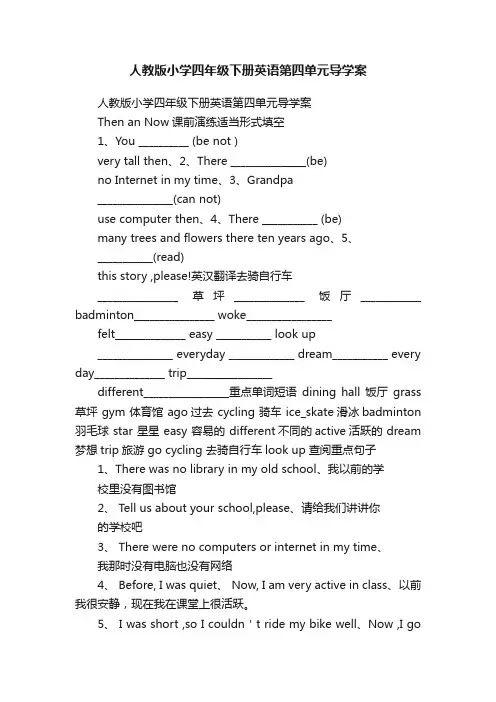
人教版小学四年级下册英语第四单元导学案人教版小学四年级下册英语第四单元导学案Then an Now课前演练适当形式填空1、You __________ (be not )very tall then、2、There _______________(be)no Internet in my time、3、Grandpa_______________(can not)use computer then、4、There ___________ (be)many trees and flowers there ten years ago、5、___________(read)this story ,please!英汉翻译去骑自行车________________ 草坪______________ 饭厅____________ badminton________________ woke_________________felt______________ easy ___________ look up_______________ everyday _____________ dream___________ every day______________ trip_________________different_________________重点单词短语dining hall 饭厅grass 草坪 gym 体育馆 ago过去 cycling 骑车 ice_skate滑冰badminton 羽毛球 star 星星 easy 容易的 different不同的active活跃的 dream 梦想trip旅游 go cycling 去骑自行车look up查阅重点句子1、There was no library in my old school、我以前的学校里没有图书馆2、 Tell us about your school,please、请给我们讲讲你的学校吧3、 There were no computers or internet in my time、我那时没有电脑也没有网络4、 Before, I was quiet、 Now, I am very active in class、以前我很安静,现在我在课堂上很活跃。
人教PEP版四年级英语下册Unit 4单元教案人教PEP版四年级英语下册Unit 4单元教案篇1第一课时教学目标1.能听、说、认读单词:these, tomatoes, try, carrots并掌握名词复数及其对应的发音。
2.会运用句型:What are these?Are they/these…?进行对话练习。
3.让学生养成多吃蔬菜和水果,远离垃圾食品的好习惯。
教学重点1.掌握单词these, tomatoes, try, carrots。
2.掌握名词的复数形式和对应的复数句子。
教学难点1.掌握tomato的复数形式tomatoes。
2.掌握单数句和复数句的相互转换。
教学准备教师准备:与本课时相关的录音和课件,本课所学的单词卡片和动物或植物的图片或实物。
学生准备:本课所需单词卡片,动物或植物的图片或相应的实物。
教学方法1.分角色表演教学法教师让同学们分角色表演Lets talk部分的对话,创设英语情景,让同学感受英语的语言氛围。
2.游戏教学法学生三人一组,进行对话:What are these?Are these apples?Are these tomatoes? Yes.在对话过程中不断增强学生的学习兴趣。
教学过程Step 1: Warm-up1.教师热情地和学生打招呼问好,做简单的Free talk。
2.播放歌曲Mary has a little lamb。
3.看图片拼读单词教师展示图片(已经学过的动物名词),说:Whats this in English?Its a/an… How do you spell it?让学生一个接一个地快速说出对应的单词及其拼写。
4.展示前三单元的单词,学生通过抢答的方式造句,教师对表现突出的同学奖励贴画。
5.Main Scene(1)学生看书36、37 页,说一说:What can you see in the picture?Where are the children?(2)找一找下列单词的意思:horses, potatoes, carrots, sheep。
Unit 4 At the farm第一课时一、教学内容Part A Let’s talk &Let’s play二、教学目标1.能正确听说句子What are these? Are these...? 并能根据实际情况进行回答。
2.正确理解与朗读对话内容,并正确表达水果和蔬菜的名称和特点。
3. 能够听说、认、读单词tomato和carrot。
三、教学重难点1. 能熟练掌握句型What are these? They are… Are these/they…? Yes /No.2. 掌握these的发音,理解这个单词的用法。
四、教学准备教学课件、录音机、磁带、简笔画五、教学过程Step 1 热身(Warming-up)1. 教师拿出一个苹果(或卡片)提问:What’s this? 学生用所学知识回答:It’s an apple. 教师继续提问:Is it an apple? 学生做肯定回答。
2. 让学生回忆询问单数物体名称的特殊疑问句和一般疑问句。
教师展示带有多个苹果的卡片,教师提问:What are they?引导学生答:They are apples. 让学生从单数概念进入到复数概念,为新课做好铺垫。
Step 2 新课呈现(Presentation)1. 学习Let’s talk(1)教师用课件出示一张有多个胡萝卜的图片,提问:Are they apples? 提示回答:No, they aren’t. 继续提问:What are they? 导出:They are carrots. 用相同方法导出tomatoes。
教师领读tomato和carrot, 重复提问和回答,练习句型和新单词:T: What are they?S: They are…T: Are they…?S: Yes, they are. /No, they aren’t.(2) 教师播放录音,让学生跟读并模仿。
指导学生注意try, some的读音,并试着翻译。
第四单元教课设计一、元教课内容剖析1、元教课内容:本元通里各样物以及作物的学,进而展了中多彩的生活。
然与学生的生活相隔甚,但其内容与学生的平时生活系密。
要修业生能用本元的句型与行有关里各样物和各样作物的表达。
2 、元教课要点::sheep, hen, cow, horse, goat, lamb及其复数形式的表达;句型 :How many⋯do you have ;四会及四会句子的掌握。
3、元教课点:字母合or 在中的音。
二、元教课目:1、能划分上常的牲口和蔬菜,如: goat, sheep, horse, donkey, tomatoes, potatoes.2 、能运用句型,如: What are they? Are they ⋯ ?How many⋯ ?物和蔬菜的名称及数目等。
3、能依据画,出一些常的畜牲和蔬菜的名称。
三、元教课准:1、教准教课程中所需要的片、声音、件,以及本元的卡。
2、准一些教的照片或片。
3、教准音机及音。
四、元教课举措:1、在教课程中,于学困的学生,可通学生复述老的或是复述同学的回答,学生老和同学的言惹起注意,学买卖到要仔听人的。
2、于学不,可是不肯或惧怕言的学生,堂中教主他表达其意,培育他优秀的学英的。
3、充足运用英名、英文歌、儿歌、口令、口溜、等,予小学生言感染的时机。
可展开各样活,鼓舞学生交。
五、元教课反省:第一课时(A Let ’stalk)教课目:1、听、、主要言构: What are these ? Are these...? 并能依据状况行略回答。
2、能正确朗。
教具准:教课光、卡片。
教课要点:句型 What are these ? Are these ⋯?及其略回答。
教课点: these 的音。
教课程:一、复引1、教和学生聊一聊每一个人喜的蔬菜。
(I like ⋯Do you like⋯?)2、教,引学生用 Are they ⋯?来猜猜是什么蔬菜。
a、They are red. They look like apples, but they aren ’t apples.What are they?b、They are tender and green. What are they?c、They are long and orange. Rabbits like eating them. What are they?d、They are round, pink and white. What are they?e、They are brown. French fries are made of them. What are they?学生猜了,教回答Yes, they are.并取出相的卡片学生拼;假如猜了,教回答No, they aren’t.再其余人猜,直到猜止。
Unit 4 4B let's talk let's play 导学案人教(PEP)四年级英语下一、教学目标1. 知识目标(1)能够听懂、会说、会读本课的生词和重点句子。
(2)能够运用所学知识进行简单的日常交流。
2. 能力目标(1)培养学生的听说能力,提高他们的语言运用能力。
(2)培养学生的团队合作精神,提高他们的交际能力。
3. 情感目标(1)激发学生学习英语的兴趣,增强他们的自信心。
(2)培养学生的跨文化交际意识,提高他们的文化素养。
二、教学内容1. 词汇:draw, see, watch, listen, look, find, numbers, four, seven, eight, nine2. 句子:Can you draw a……?Yes, I can. / No, I can't.Let's watch TV. What's this? It's a……Let's listen to music. What's that? It's a……Let's look for……I can find……3. 功能句:What's this? It's a……What's that? It's a……三、教学重点与难点1. 重点:能够听懂、会说、会读本课的生词和句子,能够运用所学知识进行简单的日常交流。
2. 难点:能够正确运用情态动词 can 进行简单的问答。
四、教具与学具准备1. 教具:多媒体课件、录音机、磁带、教学卡片2. 学具:课本、练习本、录音机、磁带五、教学过程1. 热身(5分钟)(1)唱英文歌 "Hello, Hello, Hello!"(2)老师出示各种物品,学生用中文描述。
2. 导入(10分钟)(1)老师出示数字卡片,引导学生用英文数数。
(2)老师引导学生用英文描述卡片上的物品。
四年级下册英语导学案- Lesson 4 人教精通版课程目标1.学习并掌握本课时的重点单词和短语;2.了解本课时的主题,学习相关的句型结构;3.能够运用所学知识进行简单的交流。
词汇和短语1.record player - 唱片机2.television - 电视3.sound - 声音4.dance - 跳舞5.take out - 拿出6.put away - 放回7.watch television - 看电视8.listen to the radio - 听收音机9.dance to music - 跳舞10.play with toys - 玩具11.have fun - 玩得愉快12.be quiet - 安静13.it’s time to… - 是……的时间了主题与结构本课时的主题是介绍和表述日常活动。
学生需要掌握用英语来表达做某些事情的时间,其中涉及到很多常用的动词和短语。
小学四年级的学生对于这些动词和短语的用法还不是很熟练,因此需要通过课堂学习来帮助学生掌握。
本课时的句型结构如下:1.What would you like to do?2.I’d like to watch television.3.Let’s dance to the music.4.Please take out your toys.5.Can you put away the record player?6.It’s time to be quiet.课堂练习1.听录音,完成对话。
A: What would you like to do?B: I'd like to __________ television.A: That sounds great. I also like to __________ to musicB: Let's __________ together!2.观察图片,回答问题。
PEP新版四年级英语下册第四单元导学案四年级英语导学案课题Unit4 At the farm 总课时 6 课时Lesson1年级四主备人授课人课型新授班级一、教学方法情景教学法学习准备教师准备录音机和录音带,图片学生准备笔和纸,词卡学习目标知识目标能听、说、认读单词:tomato、green beans、potato、carrot以及它们的复数形式。
能力目标能听懂会说句子:Look at the green beans,t hey’re so long.Yes,and the potatoes are big.情感态度培养学生积极与他人合作的优良品质。
重点难点新词汇的听说认读. 单词tomato和potato的复数形式。
二、导学过程导学过程二次备课自主学习课前复习:复习前面学过的有关食物和水果的名称的单词课前预习:试读Let’s learn中的单词全体学生呼英语励志口号:No pains.No gains .(没有付出就没有收获)三、热身、复习:1. 请学生欣赏Let’s chant部分歌谣,教师要根据歌词适时举起相应的图片。
四、导入新课,板书课题。
展示本课学习目标,学生齐读本课学习目标。
1.板书课题2.展示本课教学目标知识目标能听、说、认读单词:tomato、green beans、potato、carrot以及它们的复数形式。
能力目标能听懂会说句子:look at the green beans,They’re so long.Yes,and the potatoes are big.情感态度培养学生积极与他人合作的优良品质。
五、导入并指导学习新的内容:1、教师手举一个西红柿,说:I like tomatoes. Do you like tomatoes?引导学生用I like …或I don’t like…根据自己的实际情况表达。
2、教师再拿起一夹青豆,边说边完全呈现:Oh,it’s long and green. They are green beans. Do you like green beans? 让学生在回答中学习单词。
3、出示土豆:Do you know it?French f ries are made of it. It’s a potato. Do you like potatoes? 学生根据用I like …或I don’t like…根据自己的实际进行情况表达。
4、请学生猜谜语:They are long and orange. Rabbits like eating them? What are they? 学习单词carrot。
5、教师将四种蔬菜分别放在教室的不同位置,然后说单词,请学生指出相应的实物。
小班展练一小班展练tomato、green beans。
二小班展练potato、carrot。
三小班展练对话练习拓展1.小组活动一名学生说单词,其他学生举起相应的单词卡片并读出单词。
2.绘画游戏教师说:two potatoes学生在画纸上画出相应数量的蔬菜Homework:1.正确书写tomato、green beans、potato、carrot单词2.预习下节课的内容总结这节课我学会了……,我还懂得了……板书设计Unit4At the farmtomato、green beans、potato、carrotLook at the green beans. They’re so long.Yes,and the potatoes are big.课后反思Lesson2 年级四主备人授课人课型新授班级一、教学方法情景教学法学习准备教师准备录音机和录音带,作为奖励的小礼物学生准备人物头饰学习目标知识目标听、说、认读主要语言结构:What are these?Are these...?并能根据实际情况进行简略回答。
能力目标能在创设的情景中灵活运用句型What are these?和They’re…. 情感态度鼓励学生多体验生活,了解自己日常食用的蔬菜。
重点难点听、说、认读主要语言结构:What are these?Are these...?并能根据实际情况进行简略回答。
单词this 和these的区别于联系。
二、导学过程二次备课自主学习课前复习:复习前面学过的表示蔬菜名称的单词tomato、green beans、potato、carrot。
句型:What’s this?It’s…. 课前预习:试读Let’s talk对话。
全体学生呼英语励志口号:No pains.No gains .(没有付出就没有收获)三、热身、复习:1、教师和学生聊一聊每个人喜爱的蔬菜。
(I like…Do you like…?)2、教师说谜语,引导学生用Are they…?来猜猜是什么蔬菜。
a、They are red. They look like apples, but the y aren’t apples. What are they? b、They are tender and green. What are they? c、They are long and orange. Rabbits like eating them. What are they? d、They are round, pink and white. What are they? e、They are brown. French fries are made of them. What are they? 学生猜对了,教师回答Yes,they are.并拿出相应的单词卡片请学生拼读;如果猜错了,教师回答No, they aren’t. 再请其他人猜, 直到猜对为止。
四、导入新课,板书课题。
展示本课学习目标,学生齐读本课学习目标。
1.板书课题2.展示本课教学目标知识目标听、说、认读主要语言结构:What are these?Arethese...?并能根据实际情况进行简略回答。
能力目标能在创设的情景中灵活运用句型What are these?和They’re…. 情感态度鼓励学生多体验生活,了解自己日常食用的蔬菜。
五、导入并指导学习新的内容:1.教师拿出一根胡萝卜,说:This is a carrot。
再拿出几根胡萝卜,说:Look,these are some carrots.然后将这两个句子板书在黑板上,并画上相应数量的胡萝卜让学生对比,知道单词these的意思及其与单词this的区别和联系2、教师请学生将装有蔬菜卡片的盒子盖好放在桌子上,然后走到同学们中间,随意指着几个盒子问:Are these…?,并引导学生根据实际用Yes, they are. / No, they aren’t.回答。
如果学生回答的是No, they aren’t. 教师要继续问:What are these?并引导学生用They are …回答。
(教师在操作时应多问几名学生,以增加语言的输入量。
)教师适时板书句型框架。
3、教师将自己带来的蔬菜卡片分别放在几个盒子里,请几个学生过来边摸边问:Are these…?或What are these?教师做出相应的回答。
4、学生两人一组运用黑板上的句型互相猜猜对方盒内的蔬菜。
5、播放Let’s talk的录音,学生听录音,后跟读、模仿。
6、分小组做对话练习。
小班展练四小班和五小班进行角色表演,其他小班给予评价these?Are these…? 同桌之间利用蔬菜卡片进行问答操练。
Homework:1.把Let’s talk的内容读给父母听。
2.预习下节课的内容总结这节课我学会了……,我还懂得了……板书设计Unit4At the farm What’s this? This is a carrot.What are these?These are some carrots课后反思Lesson3年级四主备人授课人课型新授班级一、教学方法情景教学法学习准备教师准备录音机和录音带,图片学生准备记号笔学习目标知识目标让学生掌握含有字母组合or的单词发音和认读书写。
能力目标能听、说、读、写horse, fork, homework, world map四个词语情感态度鼓励学生多体验生活,了解自己日常食用的蔬菜。
重点难点能听、说、读、写horse, fork, homework, world map四个词语。
掌握字母组合or在单词中的不同发音/ɔ:/和/ə:/,帮助学生反复操练,辨别。
二、导学过程导学过程二次备课自主学习课前复习:复习前面学过的含有字母组合or的单词,拼读并比较。
如:for short fork world horse work 句型:What’s this?It’s…课前预习:试读Let’s spell中的单词中or字母组合的发音。
全体学生呼英语励志口号:No pains.No gains .(没有付出就没有收获)三、热身、复习:1、师生做日常口语练习: A: What are these? B: They are... A: Are these ...? B: Yes, they are./No, they aren't. 2、请学生表演A部分Let’s talk的对话。
四、导入新课,板书课题。
展示本课学习目标,学生齐读本课学习目标。
1.板书课题2.展示本课教学目标知识目标让学生掌握含有字母组合or的单词发音和认读书写。
能力目标能听、说、读、写horse, fork, homework, world map 四个词语情感态度鼓励学生多体验生活,了解自己日常食用的蔬菜。
四、导入并指导学习新的内容:Let’s spell Read,listen and chant 1.教师出示图片引出单词horse fork homework world map2.播放录音,学生跟读录音,教师注意帮助学生纠正错误发音3.让学生观察单词,引导学生发现这些单词中都含有字母组合“or”,并且他们的发音并不一样。
4.板书:horse fork for/ ɔ:/ Homework world map/ ə:/教师领读音标,学生分组训练。
Read,listen and number 请一位学生带领学生读本部分单词,然后教师播放录音,学生边听录音边给单词标号,师生一起核对答案。
Look,listen and write 教师播放录音,学生边听录音边填上缺失的单词,师生一起核对答案。
练习拓展同桌练习or字母组合的发音,教师巡视指导。
Homework:1.正确规范地书写horse, fork, homework, world map2.预习下节课的内容总结这节课我学会了……,我还懂得了……板书设计课后反思Lesson4年级四主备人授课人课型新授班级一、教学方法情景教学法学习准备教师准备录音机和录音带,词卡学生准备画笔和画纸学习目标知识目标能够听、说、认读单词:sheep,hen,cow,horse。